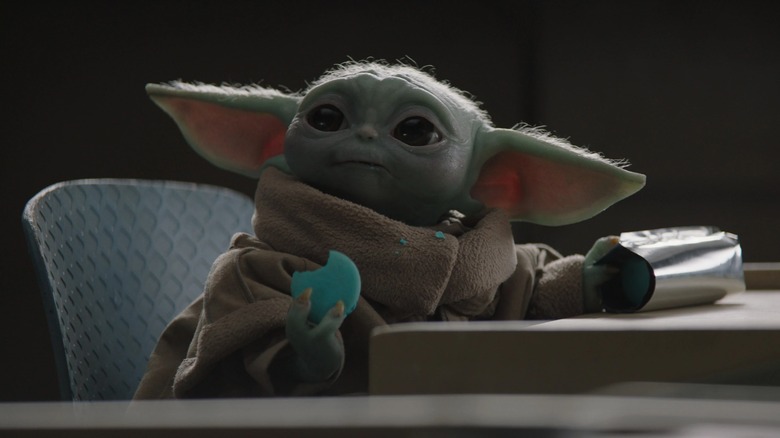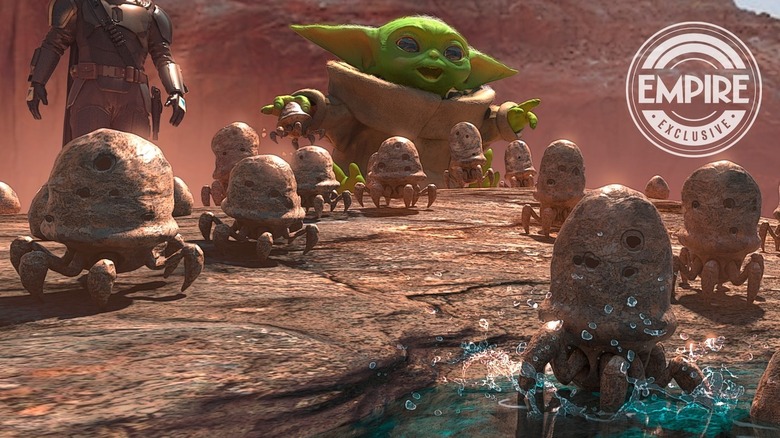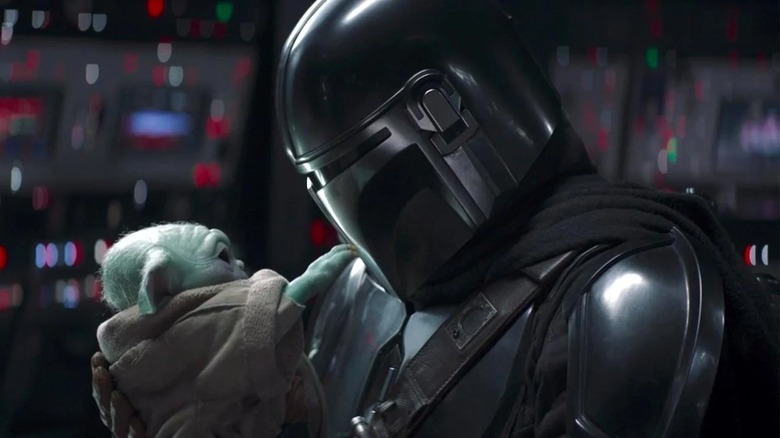Baby Yoda Was Nicknamed 'Yermit' In The Early Days Of The Mandalorian
To many casual "The Mandalorian" fans, he's "Baby Yoda." To the die-hards, his canonical name is "Grogu." In the "Star Wars" fandom, some have affectionately nicknamed him "Yodito." He goes by many names, but his adorable, bug-eyed face is widely loved by all kinds of fans. Grogu's first appearance in the pilot episode of "The Mandalorian" was a shockingly well-kept secret that quickly took over the internet.
Conceptually, Grogu is a stroke of merchandising genius. Let's take one of the most recognizable characters in the entire franchise, then make an adorable baby version for an even broader appeal. There is still no canon name for the ancient species Grogu or Yoda (and the lesser-known Yaddle) are members of, so there's a genuine air of mystique looking past his superficial cuteness.
This week, a special issue of Empire Magazine promoting season 3 of "The Mandalorian" features an oral history of the creation of Grogu from page to screen. The creatives behind the show shared some interesting tidbits of information, including yet another nickname for the green child given during the early days of production.
TaMara Carlson Woodard, a creature-effects artist, puppeteer, and specialty costumer for "The Mandalorian" who helped develop Grogu's designs, shared with Empire:
"When Scott [Patton, digital designer at Legacy Effects] and I got the brief, I was given a picture of Grogu without any clothes on — they were still trying to decide what he really looked like, what size he would be. I built a little body based off what I would want to hold, a little stuffed-animal version without a face — I called it 'Yermit', because it wasn't Yoda, and it wasn't Kermit."
Grogu's journey from concept to puppet
Dave Filoni, one of the creators/executive producers of "The Mandalorian" shared his initial reaction to co-creator/EP Jon Favreau's pitch of introducing a "Baby Yoda" type character:
"I was probably one of the first people to hear that pitch. Jon said, 'I want to make a character that's like a Baby Yoda.' I thought, 'Where are we going with this? If we're doing that, I want to help, because Yoda is such an important character to George [Lucas]. I want to help make sure it's going to come across as well as it can.'"
Favreau explained his thought process: Just because Grogu resembled familiar characters from the franchise's past doesn't mean he had to share an immediate connection with them. "We knew it wasn't Yoda — anybody who knows the timeframe ["The Mandalorian" is set after "Return of the Jedi"] knows that it can't be him," Favreau said. "Is it a clone? There's a lot of cloning going on. But he's his own person, with his own history."
From there, Filoni and Favreau started cooking with their creative teams and worked on the child's character design. Grogu would soon graduate from a little concept to a key element of the entire story. Rick Famuyiwa (a director/writer on previous seasons now serving as an EP on season 3) was shown the concept art as early as possible. "Jon and Dave showed me the first sketch that inspired it — that last image [in 'Chapter 1'] of Mando and the baby as he's in his pram, and he reaches down into it," said Famuyiwa.
It's within this piece of concept art where Favreau found the beating heart of his "Star Wars' series, and soon birthed a puppet with a $5 million budget.
Looking back on the mystery of Grogu
John Rosengrant, the founder of Legacy Effects, walked into the middle of Grogu fever during pre-production. "I had a meeting with Jon and [producer] Colin Wilson. I went into this room set up with production art all over the walls, and I saw these — as the world calls him — Baby Yoda. I'm asking, 'What is this?'"
Even though the connection between Grogu and the titular "Mandalorian" was the emotional foundation of the show, the official names/origins of both characters would remain in Favreau and Filoni's minds until the show naturally revealed that information. The show's designers and creatives were largely left in the dark in early production as well, so the mystery would be a huge part of the character design.
Carlson Woodard shared her thought process designing Grogu's outfit in season 1 of "The Mandalorian" with Empire:
"I built the costume — we knew it should have clothes, but we didn't know anything about its origin. So we said, 'Okay, somebody found this [baby], and it needs clothes ... I'm going to take something that was worn by a larger human.' I deconstructed it and then reassembled it for this smaller creature. Some pieces are structural, and a lot of pieces are hand-sewn and raggedy."
In such a short amount of time, Din Djarin and Grogu have become one of the most lovable pairings in the entire "Star Wars" franchise, but this production story reminded us of a much simpler time where he was only referred to as "the child" by the woefully unprepared marketing team and "Baby Yoda" by everyone else. It's fun to learn in retrospect that he was also once referred to as "Yermit" by the designers behind the scenes.


